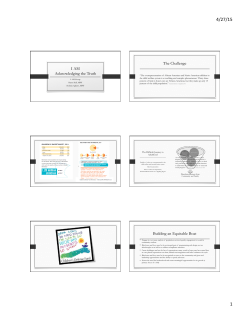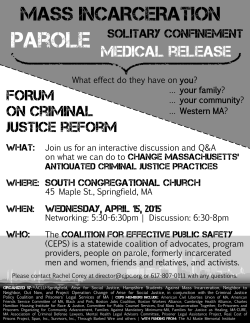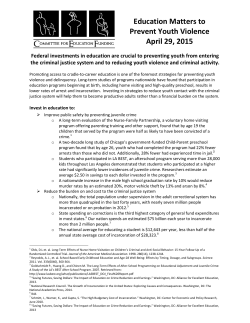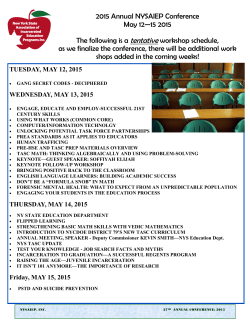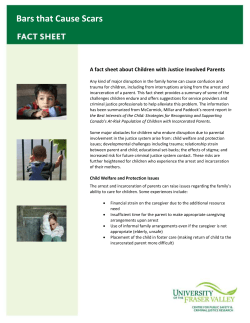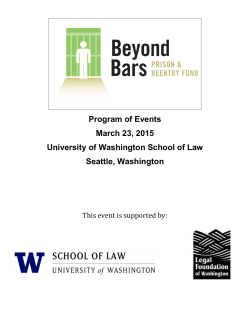
The Criminalization and Mass Incarceration of the
Running head: THE CRIMINALIZATION The Criminalization and Mass Incarceration of the Black Community Daland V. Dixon Cheyney University 1 THE CRIMINALIZATION 2 In the field of sociology one of the main focuses is on social stratification. Social stratification looks at the inequalities among people groups. In the Black community social stratification can clearly be seen in the criminalization and mass incarceration of many of its members. Ever since slavery was made illegal both the federal and local governments have enacted laws and policies the indirectly targeted Blacks and other minorities as a means of keeping power in the hands of the majority. Deborah Burris-Kitchen and Paul Burris’ work “FROM SLAVERY TO PRISONS: A HISTORICAL DELINEATION OF THE CRIMINALIZATION OF AFRICAN AMERICANS” traces the criminalization of Blacks through American history. It focuses on the periods of Slavery, Reconstruction, Jim Crow, and Post Segregation and their relationships to the political economy, denial of education for Blacks and Black criminalization. The authors also speak on the war on drugs and how it is currently used to oppress the Black community. The paper starts off by explaining the criminalization of Blacks and how a caste system was set up in America between whites and non-whites and between white indentured servants and black slaves. It then goes on to talk about slavery and how it relates to the political economy (Burris-Kitchen & Burris, 2011). According to the authors, many blacks were free and had the same rights as white servants up until the end of the 17th century. Once Blacks became slaves by law they were held down by racial hierarchy and dehumanization in order to keep the southern cotton based economy going strong and were thus second class citizens. THE CRIMINALIZATION 3 Slavery also affected the education of Blacks. Many people wanted to educate African Americans but this was frowned upon by those who profited by keeping slaves ignorant. Based on this extremely limited access to education Blacks were seen as intellectually inferior by Whites. During slavery, criminalization was used as a means to control both enslaved and free Blacks (Burris-Kitchen & Burris, 2011). The era of Reconstruction brought with it great advances for Black Americans but these were swiftly brought down by the Black Codes, the efforts and intimidation of the Ku Klux Klan, and the legalization of segregation through the ruling of Plessey vs. Ferguson. During Reconstruction Blacks were continually denied education and kept ignorant. Blacks who sought to learn, and those who sought to teach them, were faced with violence and death. Criminalization of Blacks during Reconstruction came in the form of the convict leasing system. After ratification of the 13th Amendment the institution stated that “neither slavery nor involuntary servitude, except as a punishment for crime whereof the party shall have been duly convicted, shall exist within the United States, or any place subject to their jurisdiction” (U.S. Constitution). Thus many African Americans were disproportionately arrested and leased. (Burris-Kitchen & Burris, 2011). Jim Crow laws were enacted to halt economic and political progress among Black Americans. Any access that Blacks had at this time to education was used to instill the notion that Blacks were inferior. During this time many Black men were arrested or killed because of white men’s fears that Black men would rape their women. Although Blacks have more freedom today they are still severely more disadvantaged then whites and schools and neighborhoods are still very segregated. This segregation THE CRIMINALIZATION 4 keeps Blacks from achieving in the political economy. Blacks today are still denied a quality education because most majority Black schools are underfunded. In today’s society the criminalization of Blacks is done mostly through the War on Drugs (BurrisKitchen & Burris, 2011). I feel that Burris-Kitchen and Burris handled this topic very well. In the essay they clearly traced how the periods of slavery, Reconstruction, Jim Crow, and PostSegregation affected the political economy, denial of education and criminalization of blacks at the time. Not only does it explain these individually but shows how the effects of one period spilled over into the next period and influenced events and ideologies of that period. By using this timeline approach it shines light on many of the influences responsible for the criminalization and over imprisonment of Blacks today and makes it easy to follow. “The Incarceration Explosion” written by Congressman John Conyers, Jr. speaks on the rise of the United States’ federal prison population in the last 40 years. The rate of incarceration for Black men is four times that of the national average and six times that of White men. The author argues that the war on drugs, longer range of sentencing, abolition of parole, different penalties for similar crimes, and racial control are the reasons for this increased rate. America’s war on drugs is by far the biggest contributor to the country’s incarceration rate. According to the author, half of America’s inmates were convicted on drug charges. The combination of longer sentencing and no parol is leading to an aging population of inmates (Conyers, 2013). THE CRIMINALIZATION 5 The author offers several legislative solutions to help solve these problems. The first of these solutions is to stop assigning different penalties to similar crimes. The author uses the harshness of the penalties against the use of crack cocaine versus powdered cocaine as an example of these different penalties and how the laws can be used to disproportionally affect Blacks. The second legislative solution is to offer opportunities that will reduce the likelihood of inmates returning to prison. In relation to this he mentions the Second Chance Act and how much good it does for past offenders. Unfortunately, according to Conyers (2013), this act “is currently past due for reauthorization” (p. 384). His third solution is to offer alternatives to prison. These alternatives would lower incarceration rates, reduce recidivism by 30 percent, and save taxpayer dollars. The next solution is to “create rational sentencing policies” (p. 385). The author’s main contention in this section is that mandatory minimum sentences cause judges to sentence individuals without taking into consideration the details of the actual crime. Conyers last solution is to “offer comprehensive, evidence-based prevention and intervention programs” (Conyers, 2013, p. 386). I liked the fact that the author of “The Incarceration Explosion” is a Congressman. This makes the article a critique of the federal system from the inside. This is important because the only way things in the federal government can change is if enough of its members are willing to question the actions of the government for which they work. What made the paper good was that the format for the article was fairly simple. Conyers stated the problems, investigated the causes of the problems and then offered specific solutions to them, likely drawn from his own experiences in office. THE CRIMINALIZATION 6 Ian F. Haney López’s article entitled “Post Racial Racism: Racial Stratification and Mass Incarceration in the Age of Obama” touches on what President Obama’s election means for the concept of race in America. He also examines whether mass incarceration based on race could be a response to the civil rights movement and looks at mass incarceration as a symptom of racial stratification (Haney López, 2010). Haney López (2010) examines whether the high rate of black and brown incarceration compared to white incarceration has been caused by what he calls “racialbacklash politics” (p. 1029). Naturally one might think that mass incarceration is obviously caused by mass crime, but the author shows that even though rates of incarceration have increased over the last several years, crime rates have been steadily decreasing. Haney López (2010) then offers up the option that this system of incarceration was started with and persists because of “racial politics” (p. 1032). In the 1950s and 60s politicians were very much against civil rights and what civil rights activists were doing. They frequently used crime as an excuse to counter civil rights activities like sit-ins and freedom rides. The anti-Black rhetoric was hidden as anti-crime rhetoric and this anti-crime rhetoric became anti-crime laws (Haney López, 2010). Haney López’s article “Post Racial Racism: Racial Stratification and Mass Incarceration in the Age of Obama” was standard. It was not bad, he had good information. It was also a very long article, I think he could have said what he wanted to say in a lot fewer words. Much of the same information here was found in other articles, this is not to talk down on the author though, as articles on the same and similar topics will inevitably have some of the same or similar content. THE CRIMINALIZATION 7 Kayla Martensen’s article “The price that US minority communities pay: mass incarceration and the ideologies that fuel them” focuses on the issues and ideologies of incarceration and the effects it has on both the individual and the community. The author notes that although America as a nation makes up 5 percent of the worlds population it is home to 25 percent of the worlds inmates. During World War II Whites made up 70 percent of American convicts whole non-Whites made up the remaining 30, since then this demographic has been reversed. The author then goes on to assert that around the time of the 1970s the justice system began to focus more on punishment than rehabilitation (Martensen, 2012). Because mass incarceration is primarily a problem for Black men the author suggests that they are not only physically imprisoned but also mentally imprisoned. In this day and age the word Black man are interchangeable with criminal in the minds of the public and it is this thinking that has imprisoned them. These stereotypes also affect minority women. Although their rates of imprisonment are not as high, they are rising. Disadvantaged people are also labeled as “others” according to mainstream society (Martensen, 2012, p. 214). This makes it harder for those in power to relate to them and easier to imprison them. Politicians are unable to relate to them and thus laws are never made to help them or ease their troubles because their problems are seen as different from the problems of the majority. (Martensen, 2012). These communities are also often trapped in cycles of inequality. Entrepreneurs are less likely to open shop in high crime areas, this makes access to jobs scarce. Because so many jobs are being taken out of these areas no goods or services are THE CRIMINALIZATION 8 produced here. This means that there is less accessible wealth in these communities. the author uses the education system as an illustration of this. Schools are funded by property taxes, since there is little wealth in these communities the school system is underfunded and children are not receiving the programs and education they deserve (Martensen, 2012). Mass Incarceration not only affects those who are imprisoned but also puts a burden on the family. These burdens are both financial and social. The families of those who are incarcerated must pay to stay in contact. It is also expensive for many of these families to travel from the inner city to rural areas, where most prisons are located. If a family wants an inmate to be more comfortable they must also pay for that. Finances are not the only price to pay in these situations. A stigma is often applied to the inmate and those who are close to the inmate (Martensen, 2012). I like how Martensen put focus on the mental effect of mass incarceration and criminalization and the effect these have on the community as a whole. She also goes into detail about how the conditions of the community as a whole lead to these outcomes. She then goes on to talk about the impact on family. I liked this part because often the struggles of family are only mentioned in passing. Kimberlé W. Crenshaw’s article “From Private Violence to Mass Incarceration: Thinking Intersectionally About Women, Race, and Social Control” talks about the affect that mass incarceration has on women. It highlights the fact that much of what is written about mass incarceration focus on men. The conversation frequently says little about the affect that mass imprisonment has on women. The Crenshaw uses incarceration THE CRIMINALIZATION 9 rates in the state of California to highlight the disparities of African American women. In California Black women make up 7.1 percent of the female population but 70 percent of held in detention centers and 28 percent of female inmates, women on parole, and parole violators (Crenshaw, 2012, p. 1435). The continued focus on the system of mass incarcerations affect on men distorts the problems women face in this same system. (Crenshaw, 2012). This was pretty eye opening for me to the affect that criminalization directly plays on women. I like this article because it brings something new to the table. Not many articles focus on the direct effect criminalization and incarceration play on women. Most other articles like Martensen’s “The price that US minority communities pay: mass incarceration and the ideologies that fuel them” focus on the indirect affects on women like financial and social burdens. Thomas’ work, “MASS INCARCERATION OF MINORITY MALES: A CRITICAL LOOK AT ITS HISTORICAL ROOTS AND HOW EDUCATIONAL POLICIES ENCOURAGE ITS EXISTENCE” (2013), claims that Black men are marginalized by “hostility, political rhetoric, criminal racism, and educational racism” (p. 188) According to Thomas the school to prison pipeline starts young for African American boys. Within this pipeline school policies are sending more kids to prison than to college. Thomas (2013) claims education is one of the “societal ills” that African American men must go through and that ultimately contributes to mass incarceration (p. 178). She offers up several examples of educational racism. Wealthier communities have more to spend on students, thus students in poorer communities do not get the same access to education. THE CRIMINALIZATION 10 Wealthy parents are also very unwilling to allocate resources away from their own children and toward minority children. These children are regulated to old schools in need of repair, teachers that do not believe in them, and less effective teaching techniques. (Thomas, 2013) I liked how Thomas’ article focuses on the school to prison pipeline and how it steers children towards a life of criminalization. It really puts into focus the importance of education and the school system and the opportunities it can give to and take away from students. The authors for the most part agree on many of the aspects of criminalization and mass incarceration. The numbers they gave were all congruent and they all agree that criminalization and mass incarceration are symptoms of the attempts to control Blacks after slavery and that the current war on drugs is used to continue criminalization and mass incarceration. All of the authors used secondary analysis in their articles. All of the authors cite Michelle Alexander and her book “The New Jim Crow” but other than that the sources varied. THE CRIMINALIZATION 11 References Burris-Kitchen, D., & Burris, P. (2011). FROM SLAVERY TO PRISONS: A HISTORICAL DELINEATION OF THE CRIMINALIZATION OF AFRICAN AMERICANS. Journal Of Global Intelligence & Policy, 4(5), 1-16. Conyers Jr., J. (2013). The Incarceration Explosion. Yale Law & Policy Review, 31(2), 377-387. Crenshaw, K. W. (2012). From Private Violence to Mass Incarceration: Thinking Intersectionally About Women, Race, and Social Control. UCLA Law Review, 59(6), 1418-1472. Haney López, I. F. (2010). Post-Racial Racism: Racial Stratification and Mass Incarceration in the Age of Obama. California Law Review, 98(3), 1023-1073. Martensen, K. (2012). The price that US minority communities pay: mass incarceration and the ideologies that fuel them. Contemporary Justice Review, 15(2), 211-222. doi:10.1080/10282580.2012.681165 Thomas, J. M. (2013). MASS INCARCERATION OF MINORITY MALES: A CRITICAL LOOK AT ITS HISTORICAL ROOTS AND HOW EDUCATIONAL POLICIES ENCOURAGE ITS EXISTENCE. Race, Gender & Class, 20(1/2), 177-190.
© Copyright 2025
